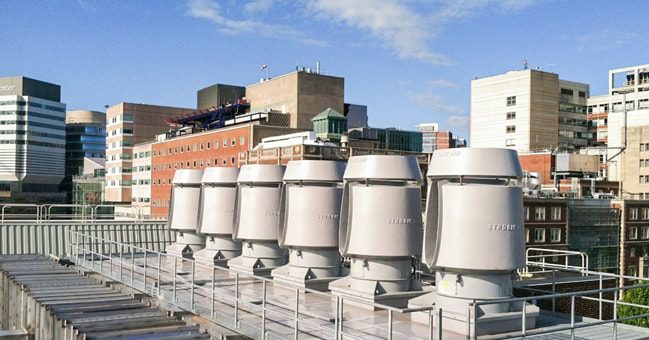Retrofitting the University of Pennsylvania’s Largest Laboratory Complex Saves Millions in Operating Costs
When it was originally built in the 1970s, University of Pennsylvania’s (UPenn) 1973 Wing (Chem 73) was a cutting edge facility with systems to support molecular research and development. By the fall of 2011, the building’s 65 chemistry labs created an energy burden with their constant volume exhaust operation. In fact, with over 100 belt-driven exhaust fans continuously running, 365 days a year, Chem 73 was conditioning and exhausting more than 280,000 cubic feet per minute (CFM). With costs at $10 per CFM, ventilation at Chem 73 exceeded $3 million annually.
Additionally, temperature fluctuations and noisy exhaust in the labs made certain processes – and even conversation – impossible. After multiple band-aid attempts to reduce energy use proved unsuccessful, the University of Pennsylvania called AHA Consulting Engineers to study the feasibility of a retrofit to the building – and ultimately design a solution. The company had provided similar science and technology design services for higher education clients across the country and was confident that its group of engineers could improve the poor laboratory environments at UPenn.
Eighty-two of the 137 fume hoods at Chem 73 dated back to their original installation in 1973. AHA worked closely with a company that provides monitoring equipment to retrofit all 137 fume hoods to accommodate fluctuating exhaust levels and to turn back automatically when not in use. AHA proposed the installation of six new high-plume exhaust fans on the roof. These were ultimately connected to a plenum that spanned both existing fan towers. This system was designed to eliminate 182,000 CFM of unnecessary airflow while maintaining peak airflow capacity in the event of an emergency. Fume hoods were then decommissioned in phases to avoid disruption to laboratory operations, while new sensors and fume hood monitors were installed. Ultimately, AHA’s HVAC solutions for Chem 73 resulted in a power consumption reduction from 735,000 kWh to 447,000 kWh – a reduction of almost 40%. Service calls to the safer and more user-friendly systems were eliminated entirely. Lab temperatures held within ¼ degree of a setpoint, and the retrofit reduced noise so significantly that many researchers now wonder if they are even operating.
AHA’s engineering services resulted in energy reductions that offered total annual savings of $1.8 million – and the project was completed 5% under budget and one month ahead of schedule.




